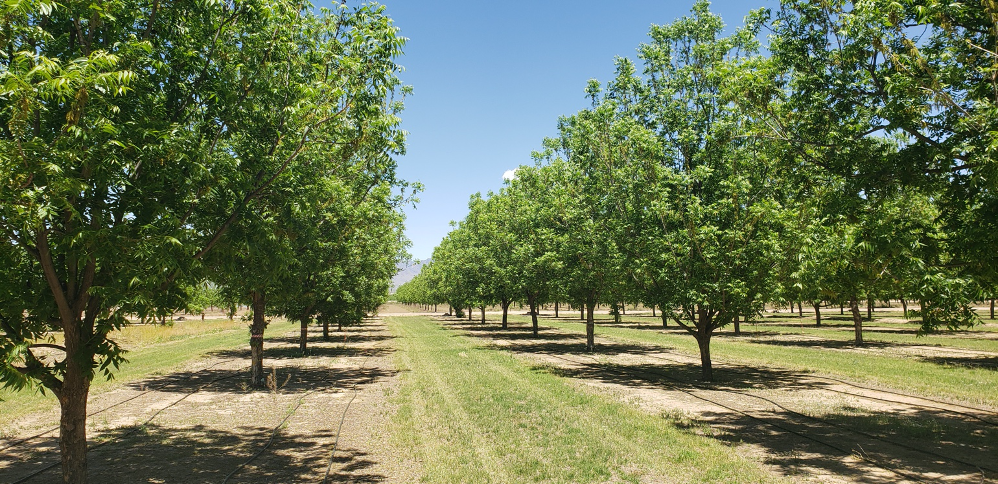
Pecan nut casebearer (PNC), is a rampant pest in pecan orchard regions from New Mexico to Florida. In New Mexico alone, it is estimated that two-thirds of the state’s growing regions have established populations of the pest, with over 70% of western pecan-producing areas containing PNC.
Although PNC is an ongoing issue for New Mexico pecan production, the New Mexico Department of Agriculture (NMDA) has surveyed and found that PNC do not seem to spread to counties where it is not established.
Life Stages
PNC, Acrobasis nuxvorella Neunzig, have three life stages: egg, larva and adult moth.
Adult PNC moths are approximately 1/3-inch in length and grey to dark grey in color. The key identifying feature of adult PNC moths, according to NMDA Program Specialist Tiffany Johnson, are the heavy, raised scaling on the forewing that resembles a ridge.
The eggs laid by adult females, she said, are oval in shape and less than a millimeter in length. Eggs when first laid are white in color, but soon after develop pink-to red-spotting. The first generation of eggs are laid singly at or near the calyx lobes of nuts after pollination, according to Oklahoma State University (OSU) Extension.
After egg hatch, PNC larvae are off-white but darken to olive-grey as they mature and are wrinkly in appearance. Mature larvae are approximately 1/2- to 2/3-inch in length before they pupate. PNC pupae are brown and roughly 1/3-inch in length, Johnson said. OSU notes that as the larvae grow and move to developing nuts, they will bore into the base of one or more nuts, leaving black excrement (frass) and silk behind.
According to Johnson, PNC overwinters as larvae in a specialized cocoon called a hibernaculum located at the base of a leaf bud. In the spring (early April) when leaf buds begin to swell and break open, the overwintering larvae emerge, feed on developing buds, then burrow into new shoot growth to pupate. Adult moths emerge roughly 9 to 14 days later, creating the first moth flight of the growing season. Depending on the orchard’s location and ambient temperatures, Johnson said, this first flight takes place near the end of April to the beginning of May. Adult females can each lay 50 to 150 eggs throughout the tree canopy.
PNC moth flights, or generations, can occur approximately six to eight weeks apart. The number of PNC moth generations in a growing season varies on location. PNC populations in western states can typically achieve four moth generations due longer and warmer growing periods, Johnson said.
Scouting and Monitoring
Scouting should be conducted for PNC in order to detect eggs and/or larvae in tandem with adult moth numbers.
OSU recommends that scouting for PNC eggs should begin one to two weeks before nut entry by larvae. This requires going into the orchard and looking for eggs on nuts and using a hand lens to determine egg maturity. Nut clusters will need to be examined to determine infestation levels.
A cluster is infested if any eggs are found or if evidence of larval entry can be observed, according to OSU. Clusters can be examined for eggs and/or larvae at a rate of ten clusters per tree.
If two or more clusters out of 310 show evidence of infestation, an insecticide application should be made immediately or one to two days after the eggs hatch. Cluster scouting should be repeated every few days if less than two clusters are infested.
Monitoring for PNC adults can be accomplished with PNC-specific pheromone traps. OSU recommends placing three traps at least 100 yards apart in an orchard that is between 30 to 50 acres and five traps in orchards larger than 50 acres.
While scouting and monitoring are both recommended for assessing PNC presence in an orchard, monitoring should occur always before any scouting measures are taken.
Control Measures
PNC larvae and adult moths can be controlled with chemical or biological methods.
OSU recommends using biological insecticides, such as Bacillus thuringiensis (Bt), instead of synthetic pyrethroids, carbamates or organophosphates to reduce impacts to beneficial insects. Bt has proven effective against larval stages of moths; however, the toxin is susceptible to harsh environmental conditions, so proper timing should be followed for best results.
Beneficial insects are a less studied method of biological control for PNC, but Johnson said that there are multiple insects that have been documented to prey on PNC. The adults and larvae of ladybugs, ash grey lady bugs, brown lacewings and green lacewings, she said, will feed on eggs and larvae. Several species of parasitic wasps can parasitize eggs and larvae. Larvae predation/parasitism is limited to periods of time when the larvae is outside of the nutlet, such as overwintering larvae leaving the hibernaculum. Additional predators known to feed on adult moths include spiders, bats and birds.
While beneficial insect feeding can affect PNC survivability, Johnson noted that the exact impact they have on PNC abundance is currently unknown.











